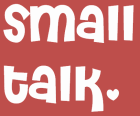Is your child's communication typical?
birth to 5 months

Reacts to loud sounds
Turns head toward a sound source
Watches your face when you speak ·
Vocalizes pleasure and displeasure sounds (laughs, giggles, cries, or fusses)
Makes noise when talked to
Smiles in response to caregivers voice
Copies facial expressions
Maintains eye contact
Turns head toward a sound source
Watches your face when you speak ·
Vocalizes pleasure and displeasure sounds (laughs, giggles, cries, or fusses)
Makes noise when talked to
Smiles in response to caregivers voice
Copies facial expressions
Maintains eye contact
6 to 12 months

Understands "no", “come here” and “bye-bye”
Plays peek-a-boo
Babbles (says "ba-ba-ba" or "ma-ma-ma")
Copies sounds and some words
Says 1 or 2 words
Tries to communicate by actions or gestures
Plays peek-a-boo
Babbles (says "ba-ba-ba" or "ma-ma-ma")
Copies sounds and some words
Says 1 or 2 words
Tries to communicate by actions or gestures
13 to 18 months
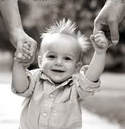
Attends to a book or toy for about two minutes
Follows simple directions accompanied by gestures
Answers simple questions nonverbally
Points to objects, pictures, and family members
Says two to three words to label a person or object (pronunciation may not be clear)
Can say 8-10 words (pronunciation may be unclear)
Makes a few animal sounds
Tries to imitate simple words
Starting to copy other children
Pretends to brush teeth, comb hair, feed others
Knows a few body parts
Follows simple directions accompanied by gestures
Answers simple questions nonverbally
Points to objects, pictures, and family members
Says two to three words to label a person or object (pronunciation may not be clear)
Can say 8-10 words (pronunciation may be unclear)
Makes a few animal sounds
Tries to imitate simple words
Starting to copy other children
Pretends to brush teeth, comb hair, feed others
Knows a few body parts
19 months to 2 years
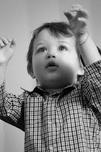
Enjoys being read to
Follows simple commands without gestures
Points to simple body parts such as "nose."
Understands simple verbs such as "eat," "sleep."
Correctly pronounces most vowels and n, m, p, h, especially in the beginning of short words. ·
Asks for common foods by name
Makes animal sounds such as "moo."
Starting to combine words such as "more milk."
Begins to use pronouns such as "mine."
May drop the last sound off words (resolves about 2 yrs)
Follows simple commands without gestures
Points to simple body parts such as "nose."
Understands simple verbs such as "eat," "sleep."
Correctly pronounces most vowels and n, m, p, h, especially in the beginning of short words. ·
Asks for common foods by name
Makes animal sounds such as "moo."
Starting to combine words such as "more milk."
Begins to use pronouns such as "mine."
May drop the last sound off words (resolves about 2 yrs)
2 to 3 years

By age 2, knows about 50 words and can say 40 words
Knows some spatial concepts such as "in," "on"
Knows pronouns such as "you," "me," "her."
Knows descriptive words like "big/little", "happy/sad."
Answers simple questions
Begins to use more pronouns such as "you," "I."
Speaks in two to three word phrases
Uses inflection to ask for something (e.g., "My ball?")
Begins to use plurals such as "shoes" or "socks" and regular past tense verbs such as "jumped."
Around 2½ years articulates h,b,m,n,ng,d,p,w,t,d,k,g and at the end of words may use s,z,ch,sh,f
By 3 years can articulate f,j and most consonant clusters (eg. pl,bl,nt,kw,st,sn) especially at the end of words
By 3 years may lisp or slightly distort l,r,s,sh,ch,y,v,z,th.
Otherwise uses 100% correct consonants in the beginning, middle, and end of words. ·
75% intelligible to strangers
By age 3, can answer “yes” and “no” correctly
By age 3, can count to 3
Knows some spatial concepts such as "in," "on"
Knows pronouns such as "you," "me," "her."
Knows descriptive words like "big/little", "happy/sad."
Answers simple questions
Begins to use more pronouns such as "you," "I."
Speaks in two to three word phrases
Uses inflection to ask for something (e.g., "My ball?")
Begins to use plurals such as "shoes" or "socks" and regular past tense verbs such as "jumped."
Around 2½ years articulates h,b,m,n,ng,d,p,w,t,d,k,g and at the end of words may use s,z,ch,sh,f
By 3 years can articulate f,j and most consonant clusters (eg. pl,bl,nt,kw,st,sn) especially at the end of words
By 3 years may lisp or slightly distort l,r,s,sh,ch,y,v,z,th.
Otherwise uses 100% correct consonants in the beginning, middle, and end of words. ·
75% intelligible to strangers
By age 3, can answer “yes” and “no” correctly
By age 3, can count to 3
3 to 4 years
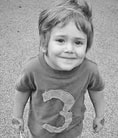
Groups pictures into categories eg. ‘foods’ or ‘clothes’
Identifies colours
Says “boy” and “girl” correctly
Able to describe the use of objects such as ‘fork,’ ‘car,’
Has fun with language. Enjoys poems. Recognizes absurdities such as, "Is that an elephant on your head?"
Expresses ideas and feelings rather than just talking about the world around him or her
Uses verbs that end in "ing," such as "walking", "talking."
Answers simple questions such as "What do you do when you are hungry?"
Repeats sentences
By age 4 child is at least 90% intelligible to strangers
Identifies colours
Says “boy” and “girl” correctly
Able to describe the use of objects such as ‘fork,’ ‘car,’
Has fun with language. Enjoys poems. Recognizes absurdities such as, "Is that an elephant on your head?"
Expresses ideas and feelings rather than just talking about the world around him or her
Uses verbs that end in "ing," such as "walking", "talking."
Answers simple questions such as "What do you do when you are hungry?"
Repeats sentences
By age 4 child is at least 90% intelligible to strangers
4 to 5 years

Understands spatial concepts such as "behind"
Understands complex questions
Speech is understandable but makes mistakes pronouncing long or complex words such as "hippopotamus"
Says about 200 - 300 different words
Uses some irregular past tense verbs such as "ran", "fell."
Describes how to do things such as painting a picture
Defines words
Lists items that belong in a category eg. animals, vehicles
Answers "why" questions
Correctly produces r,l,ch,v and discontinues lisping
Understands complex questions
Speech is understandable but makes mistakes pronouncing long or complex words such as "hippopotamus"
Says about 200 - 300 different words
Uses some irregular past tense verbs such as "ran", "fell."
Describes how to do things such as painting a picture
Defines words
Lists items that belong in a category eg. animals, vehicles
Answers "why" questions
Correctly produces r,l,ch,v and discontinues lisping
5 years and beyond
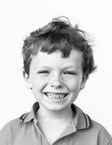
Understands more than 2,000 words ·
Understands time sequences (1st, 2nd, 3rd) ·
Carries out a series of three directions ·
Recognises and can make up rhymes
Engages in conversation ·
Sentences can be 8 or more words in length ·
Uses compound and complex sentences ·
Describes objects ·
Uses imagination to create stories
Understands time sequences (1st, 2nd, 3rd) ·
Carries out a series of three directions ·
Recognises and can make up rhymes
Engages in conversation ·
Sentences can be 8 or more words in length ·
Uses compound and complex sentences ·
Describes objects ·
Uses imagination to create stories
